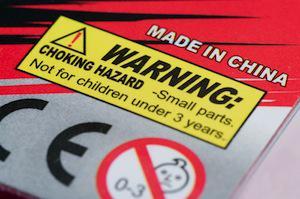
Pay Attention to the Packaging
All toys should have an age recommendation on their packaging materials. Sometimes, parents consider these as a set of guidelines; however, they are actual warnings to let parents know there may be risks involved with giving the toy to a child that is younger than the minimum recommended age. Other important warnings—small parts that may pose a choking hazard, or do not expose or use near fire—are often listed on the outside of the package.
Throw Away Packaging Materials and Broken Toys
Once a child opens a toy, parents should immediately discard of any packaging material because these items—plastic bags, zip ties, packing peanuts—can pose just as much of a threat to children as a hazardous toy. Some packaging materials are toxic. All are intended to be thrown away. Parents should also check toys regularly and throw away any that are damaged, worn or broken. These items may have small or sharp parts, could become a fire or shock hazard, or could pose a strangulation risk.
Register Toys and Check for Recalls
With many toys, parents are given the option to register the item so they can be notified of recalls. These little cards often get tossed out with the packaging, but filling them out and sending them in is one of the best and fastest ways to receive notification if the toy is later found to pose a safety risk. For toys that do not come with the option to register, parents can stay up-to-date by checking recall news online or at store bulletins.
Be Wary of Battery Housings
Each year, more than 2, 800 children are treated for swallowing button batteries. These small, round batteries, found in everything from toys to remote controls and key fobs, are extremely dangerous when ingested. They release toxins from the second they are swallowed and can cause serious illness that can quickly become deadly.
Parents can protect their children from these lethal but common items by checking all battery housings and making sure they are not easy to remove before allowing children to play with toys. Once the toy is deemed safe, it is important to check the housing regularly to ensure that it has not come loose in any way. Also, keep any items that may not have secure battery housings (i.e. television remotes) out of reach of small children.
Supervise Play
Children are exploratory by nature so, even if you follow all the guidelines, they may find a defect you might have missed. Or a toy may break or become damaged while they are playing and swallow small parts. Or, they may enter an older sibling's room or play space and swallow small parts to a toy that is not their own. The only way to prevent these risks is to supervise young children while they are playing.
Defective Products and the Injuries They Cause
Sadly, there are cases in which children are injured or killed before a toy defect is found. If this has happened to your child, you may be able to receive compensation. However, toy companies may try to avoid paying out that compensation. Ensure that there is someone on your side, protecting your rights, by contacting the experienced and professional Appleton defective products attorneys or Green Bay defective product attorneys at [[title]] Schedule your free initial consultation by calling 920-739-7366 today.
Sources:
http://www.thv11.com/story/life/holidays/2015/12/14/protect-your-child-from-toy-related-injuries/77278556/
http://www.safekids.org/safetytips/field_risks/batteries


